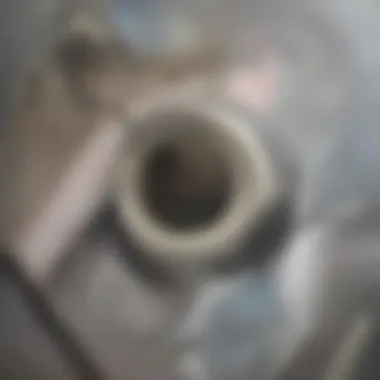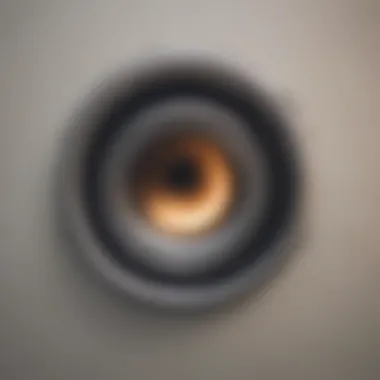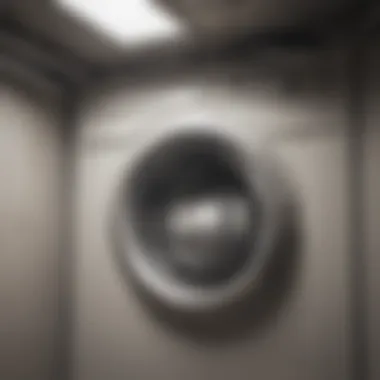Expert Guide to Cleaning Your Dryer Exhaust Vent


Intro
Cleaning the exhaust vent of a dryer is a vital, yet often overlooked task for homeowners. An unclean vent can lead to reduced efficiency, increased energy costs, and potentially dangerous situations, including fire hazards. This guide provides straightforward steps to help ensure your dryer operates safely and efficiently. Readers will find practical advice along with necessary tools and materials for effective cleaning. By following this comprehensive guide, you contribute to your appliance's longevity and your home's safety.
Importance of Cleaning Your Dryer's Exhaust Vent
Neglecting the cleaning of your dryer exhaust vent has serious consequences. Lint buildup can obstruct airflow, causing the dryer to work harder. This, in turn, can lead to longer drying times. Over time, this extra effort not only increases wear and tear on the appliance but also raises utility bills significantly.
Moreover, lint is highly flammable. Accumulation in the vent can ignite and result in devastating fires. According to the National Fire Protection Association, failure to clean dryers is the leading cause of home dryer fires. Thus, regular maintenance is essential for both efficiency and safety.
Tools and Materials Needed
Before starting the cleaning process, gather the necessary tools and materials. Having everything ready helps make the task go smoothly.
Essential Tools:
- Screwdriver (flathead and Phillips)
- Vacuum cleaner with hose
- Lint brush or a long-handled brush
- Duct tape
- Safety goggles
- Dust mask
Additional Materials:
- New vent hose (if needed)
- Cleaning wipes or cloths
Step-by-Step Instructions for Cleaning the Exhaust Vent
- Turn Off and Unplug the Dryer
- Disconnect the Vent from the Dryer
- Inspect the Vent Duct
- Clean the Duct
- Clean the Outside Vent Hood
- Reassemble and Secure Everything
- Test Your Dryer
- Safety first. Ensure the dryer is completely off and unplugged before beginning any cleaning.
- Use the screwdriver to remove the vent clamp that secures the duct to the back of the dryer. Carefully detach the vent.
- Check for visible lint and blockages. If the duct is severely damaged or kinked, consider replacing it with a new vent hose.
- Use a vacuum cleaner with a hose to remove lint from the duct. For stubborn blockages, use a lint brush to dislodge debris.
- Make sure to clean both the inside and outside vent hoods as lint can accumulate here too. Ensure the fan functions correctly when you open it.
- Once cleaned, reattach the vent to the dryer and secure it with a vent clamp. Make sure everything is tight and secure.
- Plug the dryer back in and run it for a few minutes to ensure it operates smoothly without any strange noises.
To maintain optimal performance, clean your dryer's exhaust vent every six months for best results.
Closure
Cleaning the exhaust vent on your dryer is a straightforward but crucial home maintenance task. By keeping your vent clean, you promote efficiency and minimize potential hazards. Remember to schedule regular cleanings and to check your appliance's vent system frequently. Your dryer will thank you with improved performance and safety.
For more detailed information on home safety and maintenance, consider visiting Wikipedia or Britannica.
Engaging in this simple task not only protects your home but also empowers you as a homeowner.
Prologue to Dryer Exhaust Vents
Understanding the role and significance of dryer exhaust vents is fundamental for efficient laundry practices in any home. The exhaust vent serves a critical function in venting out heat, moisture and lint, all of which can accumulate during the drying process. Without a proper functioning exhaust system, issues like increased drying times, potential damage to the dryer, and even fire hazards can arise.


Understanding Dryer Exhaust Systems
Dryer exhaust systems comprise various components that work together to expel air from the machine to the outside. Key elements include the dryer itself, exhaust ductwork, and the exterior vent cap. Proper airflow is essential for dryer operation; if any part of this system is obstructed, it will impede performance. Regular inspection and maintenance of these components contribute to the longevity and effective functioning of the appliance.
The Importance of Cleaning
Keeping the dryer exhaust vent clean is not just about efficiency; it also has implications for safety and appliance longevity. Understanding the importance of cleaning helps a homeowner prevent serious issues. Several significant factors can be examined:
Preventing Fire Hazards
Lint buildup is often ignition source in dryer-related fires. Each year, thousands of fires ignite due to improper maintenance of dryer vents. The necessity of cleaning cannot be overstated, as a clean vent dramatically lowers the risk of a fire outbreak. By ensuring the vent is clear of lint and debris, especially in older systems, homeowners take essential steps toward a safer residence.
Enhancing Dryer Efficiency
A clean exhaust vent allows the dryer to operate under optimal conditions. When the airflow is unrestricted, drying times decrease significantly. This translates to less energy consumption, which can lead to cost savings on utility bills. Maintaining an efficient dryer also ensures that clothes are adequately dried, reducing the likelihood of mildew or odor developing in fabrics.
Extending Appliance Lifespan
Frequent cleaning of the exhaust vent system can prolong the life of the dryer. Reduced strain on the machine means fewer repairs and potential breakdowns. An appliance that runs efficiently and does not overheat operates more effectively over time. Investing time in regular maintenance yields practical benefits, especially as high-quality dryers can represent a considerable investment.
Common Signs of Clogged Exhaust Vents
Recognizing the signs of clogged exhaust vents plays a significant role in maintaining the efficiency and safety of your dryer. Ignoring these indicators can lead to detrimental effects, including fire hazards and reduced appliance performance. Being aware of these signs enables homeowners and DIY enthusiasts to take timely action. This section outlines the most visible symptoms that your dryer’s exhaust vent may be obstructed.
Increased Drying Times
When your dryer takes longer than usual to dry clothes, it may be a symptom of clogged vents. A well-functioning dryer typically cycles complete loads within the expected time frame. If you find yourself running multiple cycles for a single load, this could suggest that airflow is restricted. The dryer attempts to push air through the duct, but a blockage reduces efficiency. This not only wastes energy but also places unnecessary strain on the motor.
If you notice consistently longer drying times, check the exhaust vent for possible blockages. A simple inspection can prevent escalating problems that might require costly repairs.
Burning Smell
A burning smell during a drying cycle is alarming. This odor often indicates that the dryer is overheating due to insufficient airflow. The heat generated by the dryer can build up in the restricted ducts and trigger a burning smell.
Ignoring this smell may result in further complications or even a potential fire hazard. If you encounter this scent, it is crucial to stop the dryer immediately and inspect the venting system. Clean any debris and ensure that all components are functioning properly before resuming use.
Frequent Overheating
Frequent overheating of your dryer can be another unmistakable sign of clogged exhaust vents. In normal conditions, dryers are designed to operate at specific heat levels to ensure proper drying. When airflow is obstructed, heat cannot escape as intended. This can lead to overheating, which poses significant risks, including equipment damage and fire.
If your dryer frequently shuts off due to overheating, evaluate the exhaust vent and ducting. Addressing this issue quickly is essential, as continuous overheating can severely affect the lifespan of the appliance, forcing early repairs or replacement.
Remember: Recognizing these signs early can save you time, money, and potential hazards associated with dryer exhaust vent clogs.
Safety Precautions Before Cleaning
Cleaning the exhaust vent of a dryer is a task that requires careful consideration of safety protocols. Neglecting safety can lead to electrical hazards, accidents, or injuries. Proper precautions not only protect you but also ensure that the cleaning process is effective and safe.
Disconnecting the Power Supply
Before starting the cleaning process, it is crucial to disconnect the power supply. This prevents the dryer from accidentally turning on while you are working on it. Unplugging the dryer from the wall is the best way to ensure your safety. For those with gas dryers, turn off the gas supply as well. This reduces the risk of electrical shock or gas leaks, which can pose serious dangers.
Remember to verify that the power is off before proceeding. This simple step can prevent accidents and injuries.


Ensuring Proper Ventilation
Proper ventilation is another important safety precaution. Make sure the area is adequately ventilated while you clean the exhaust vent. Dust and lint can release into the air, potentially causing respiratory issues. Open windows and doors can help maintain airflow and reduce dust accumulation. Ideally, perform this task outdoors when possible, as it minimizes health risks associated with inhaling airborne debris.
Using Personal Protective Equipment
Utilizing personal protective equipment (PPE) is essential during the cleaning process. Wear gloves to protect your hands from sharp edges or abrasive materials found in the vent system. Safety goggles should also be worn to shield your eyes from dust and lint. A mask or respirator is advisable to filter out any particles in the air, particularly if you have allergies or respiratory conditions. These precautions further ensure your safety and provide a better experience as you work.
Taking these safety precautions seriously is essential. They significantly reduce the chances of accidents and promote a smoother and more efficient cleaning process.
Necessary Tools and Materials
Cleaning the exhaust vent of a dryer involves several specific tools and materials. Each tool has its purpose and importance in ensuring the cleaning process is effective and thorough. Understanding what is required helps in reducing the time spent on the task and ensures safety during the process.
Basic Tools Required
Screwdriver
A screwdriver is crucial for removing the vent cover and other accessed panels on the dryer. The key characteristic of a screwdriver is its ability to fit into head shapes of screws, ensuring a proper fit when turning and loosening. A Phillips-head screwdriver is often beneficial, as most vent covers use Phillips screws. This tool stands out because it provides better grip and torque compared to a flathead screwdriver. A common disadvantage is if it's the wrong size; this can strip the screws and make the task harder.
Vacuum Cleaner
Using a vacuum cleaner is very effective in removing lint and dust from the exhaust duct. It is capable of sucking up even the most stubborn debris. The key characteristic of a vacuum cleaner is its suction power, which can vary between models. A vacuum with a hose attachment allows you to reach deep into ducts. A strong benefit of using a vacuum cleaner is its efficiency – it saves time and minimizes the need for other cleaning solutions. However, ensure that the vacuum itself has a filter that can handle fine particles. Otherwise, it can release dust back into the air, negating the cleaning effort.
Duster
A duster, particularly an extendable one, is useful for collecting loose dust around the dryer and in less accessible areas. The key characteristic of a duster lies in its design, often featuring a soft and flexible head that conforms to surfaces. This makes it a popular choice as it helps ensure no dust remains. One unique feature of many dusters is their ability to trap dust instead of just moving it around. However, a disadvantage might be their limited usefulness for heavier debris. They should not be the only tool used in this process but can complement the other tools nicely.
Cleaning Solutions and Alternatives
After using tools, cleaning solutions may be necessary to maintain a clean exhaust vent. Choosing the right solutions is important in ensuring the effectiveness of the cleaning process.
Soap and Water Mixture
A simple soap and water mixture works well for cleaning greasy residues that might accumulate on the vent cover and duct. The key characteristic of this mixture is its ability to break down dirt effectively. This makes it a popular choice for many homeowners, as it is both accessible and economical. The unique feature of using soap mixed with warm water is gentle cleaning without chemicals, making it safe. One disadvantage is that it may not be as effective on stuck grime, which might require stronger cleaners.
Commercial Cleaners
Commercial cleaners designed specifically for dryer vents are available and can be beneficial in breaking down significant buildup of lint and dust. The key characteristic of these cleaners is their chemical formulation, which targets tough residues. Their popularity lies in their effectiveness and convenience. Users often find these products faster than a homemade solution. However, a potential disadvantage is that some commercial cleaners may contain harsh chemicals that can be harmful if safety precautions are not followed. Reading instructions carefully before use is essential.
Keeping your tools and materials organized before starting the cleaning process can greatly enhance efficiency and safety.
Understanding the necessary tools and cleaning solutions enhances the overall cleaning experience and ensures improved operation of the dryer.
Step-by-Step Guide to Cleaning the Exhaust Vent
Cleaning the exhaust vent of a dryer is essential for its efficient operation and safety. Proper maintenance can prevent serious issues such as overheating and fires. By following a structured approach, you ensure every step contributes to the overall goal of effective cleaning and optimal function.
Removing the Vent Cover
To start, locate the vent cover on your dryer. This component shields the opening from debris and weather elements. Removing the vent cover is straightforward. Usually, you will need a screwdriver to detach it. Make sure to keep the screws safe for reassembly. After removing the cover, examine it for any signs of lint buildup or blockages. A clear cover indicates that the initial cleaning will go smoother.
Cleaning the Exhaust Duct


Using a Vacuum
Using a vacuum is an efficient method for clearing lint and debris from the exhaust duct. A vacuum cleaner equipped with a long hose can reach deep into the duct. It effectively removes accumulated lint that poses a risk of fire or obstructs airflow. One key characteristic of vacuuming is its ability to clean without creating a mess. However, ensure your vacuum has a strong suction and ideally features attachments designed for dryer vents. This is a popular choice in this cleaning process. An alternative could be a leaf blower, but that might not always work perfectly. If you choose a vacuum, remember that regular maintenance of the vacuum itself is also important to keep it effective.
Applying Cleaning Solutions
After vacuuming, applying cleaning solutions can enhance the cleaning process for stubborn residues. A simple mixture of soap and water is effective for removing grime on surfaces. The benefits of applying cleaning solutions include breaking down the sticky lint and ensuring a comprehensive approach. It is important to use a solution that is not harsh, as some may damage vent materials. When using commercial cleaners, always follow the manufacturer’s instructions to avoid any harm. In general, using cleaning solutions helps prevent buildup in the future.
Checking the Exterior Vent
Once the duct is clean, it is crucial to check the exterior vent. This section can also trap lint and debris if not cleaned regularly. Make sure the vent opens and closes freely, facilitating good airflow. Blockages here can lead to excess heat build-up, which may damage the dryer or create a fire hazard. Use a brush or your vacuum to ensure this area is clear.
Reassembling and Testing
After cleaning, it is time to reassemble the vent cover. Make sure it is tightened securely and positioned correctly to avoid any leaks. Once assembled, conduct a test run of the dryer. Monitor for proper airflow at the exterior vent and ensure there are no unusual noises or heating issues. This step is vital to confirm that the cleaning process has been effective and that your dryer operates safely.
Regular Maintenance Tips
Regular maintenance of your dryer’s exhaust vent is crucial for several reasons. First, it ensures that the appliance operates at peak efficiency. When vents are clean, dryers run smoothly and consume less energy. This can translate into lower utility bills. Beyond savings, regular cleaning reduces the risk of fire hazards. Lint accumulation can be highly flammable, making it imperative to keep vents clear.
Furthermore, establishing maintenance routines helps prolong the lifespan of your dryer. If a dryer is not well-maintained, it can suffer from various issues over time, leading to more significant breakdowns and costly repairs.
Incorporating regular checks into your household routine also enhances safety. When everyone in the household understands the importance of these tasks, it fosters a culture of maintenance. Small efforts can prevent major problems.
Setting a Cleaning Schedule
To effectively maintain your dryer, it is essential to set a cleaning schedule. This could be as routine as marking it on a calendar. Most experts suggest cleaning the exhaust vent at least once a year.
It might be beneficial to inspect more frequently if you notice any signs of clogging, such as slower drying times. Creating a schedule means you are less likely to forget the task. Also, aligning this schedule with other regular household chores can make it seem less daunting.
Inspecting the Venting System
Regular inspection of the venting system is vital. This can reveal potential issues before they become serious. When you check the vent, look for any kinks or bends that could trap lint. Also, examine the connection points to ensure they are secure.
It’s also important to assess the exterior vent cover. Ensure it opens freely during dryer operation. This part of the system is often overlooked but essential for proper airflow. If the vent isn’t clear outside, it can hinder the dryer’s performance.
Educating Household Members
Education plays a key role in dryer maintenance. Sharing information about the risks associated with dirty vents can engage the whole family in the cleaning process. Explaining how lint buildup affects efficiency and safety reinforces the need for collective responsibility.
Consider involving household members in the cleaning process. Showing them how to inspect and clean helps them understand its significance. This can foster teamwork and ensure the task is more manageable.
"A family that maintains together, ensures safety and efficiency together."
Ultimately, regular maintenance transforms an occasional task into a habitual practice, ensuring both the efficiency and safety of your dryer.
Finale
Cleaning the exhaust vent on a dryer is essential for multiple reasons that span both efficiency and safety. In the context of regular home maintenance, it becomes clear that this task should not be overlooked. Clogged vents can lead to an array of problems that may significantly impact how the appliance operates. Not only does neglecting this maintenance cause increased drying times, but it also poses a fire hazard due to lint buildup. Therefore, prioritizing this task ensures better performance and safety in the long run.
Summary of Key Points
To summarize, key points emphasized include:
- Regular Cleaning is Vital: Regular maintenance of the exhaust vent prevents lint buildup. This helps avoid hazardous situations, making your home safer.
- Increased Efficiency: A clean vent allows the dryer to operate at peak efficiency. It reduces the drying times and enhances the appliance's lifespan.
- Awareness of Warning Signs: Understanding the signs of a clogged vent can prompt timely intervention. A burning smell or prolonged drying times should never be ignored.
- Structured Cleaning Process: Following a systematic cleaning protocol leads to effective results. Each step, from removing the vent cover to reassembling the machine, matters.
Encouragement for Regular Cleaning
It is highly recommended for homeowners to establish a routine cleaning schedule for their dryer exhaust vent. Incorporating this task into periodic home maintenance not only prolongs the life of the appliance but also safeguards the entire household from potential hazards. Setting reminders or using a seasonal cleaning checklist can encourage this practice. With just a little effort, one can ensure that the dryer operates smoothly and safely. Taking action today can prevent unforeseen issues in the future.







